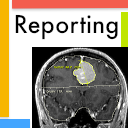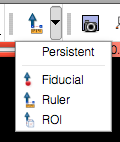Difference between revisions of "Documentation/4.1/Extensions/Reporting"
| Line 43: | Line 43: | ||
* 3-d segmentation (label map). | * 3-d segmentation (label map). | ||
The 3-d segmentations are stored as binary image masks, and are serialized into DICOM Segmentation Storage objects, which in turn can be referenced from the AIM XML document. | The 3-d segmentations are stored as binary image masks, and are serialized into DICOM Segmentation Storage objects, which in turn can be referenced from the AIM XML document. | ||
| + | |||
| + | Reporting module is available as an extension that can be installed using [[Documentation/4.1/SlicerApplication/ExtensionsManager|Slicer Extension Manager]]. | ||
| + | |||
| + | '''Note to Mac OS X users:''' we are currently working on packaging issues that prevent Reporting extension to be usable on Mac. Until this issue is resolved, please use the packaged version of Slicer that can be downloaded [https://dl.dropbox.com/u/3770904/Slicer-4.1.0-2012-08-16-macosx-amd64.dmg using this link]. This package has Reporting module included. As soon as the issue is resolved, this page will be updated accordingly. | ||
|} | |} | ||
| Line 57: | Line 61: | ||
<!-- ---------------------------- --> | <!-- ---------------------------- --> | ||
{{documentation/{{documentation/version}}/module-section|Panels and their use}} | {{documentation/{{documentation/version}}/module-section|Panels and their use}} | ||
| + | |||
| + | Before you start using the module, you need to be familiar with 3D Slicer interface and main features. Please see instruction on using the [[Documentation/4.1/SlicerApplication/MainApplicationGUI|main application GUI]] and [[Documentation/4.1/Training|various tutorials]] to learn about 3D Slicer. | ||
| + | |||
| + | Reporting module uses internal data structure called "report" to organize the markup/annotations and associate them with the image volume being annotated. | ||
The steps to create a new report are the following: | The steps to create a new report are the following: | ||
| Line 87: | Line 95: | ||
* ''Segmentation'' panel | * ''Segmentation'' panel | ||
** ''Segmentation volume'' selector allows to choose the volume containing the segmentation, or to create a new segmentation. For an existing label map (segmentation) to be associated with the active report, the geometry of the image volume containing the segmentation should match the geometry of the annotated volume. New segmentation volume can be created to match the geometry of the active volume using the segmentation selector. | ** ''Segmentation volume'' selector allows to choose the volume containing the segmentation, or to create a new segmentation. For an existing label map (segmentation) to be associated with the active report, the geometry of the image volume containing the segmentation should match the geometry of the annotated volume. New segmentation volume can be created to match the geometry of the active volume using the segmentation selector. | ||
| − | ** Once the label volume is selected/created, it can be edited using the Editor tools: these are available by expanding the "Edit Selected Label Map" panel (see figure on the right). | + | ** Once the label volume is selected/created, it can be edited using the [[Documentation/4.1/Modules/Editor|Editor]] tools: these are available by expanding the "Edit Selected Label Map" panel (see figure on the right). |
* ''Save/Load'' buttons allow to export/import the report into AIM format. | * ''Save/Load'' buttons allow to export/import the report into AIM format. | ||
| | | | ||
| Line 96: | Line 104: | ||
[[Image:Slicer4-SegmentationSelector.png|thumb|280px|New label volume can be created using the "Segmentation volume" selector]] | [[Image:Slicer4-SegmentationSelector.png|thumb|280px|New label volume can be created using the "Segmentation volume" selector]] | ||
| − | [[Image:Slicer4-ReportingEditor.png|thumb|280px|Segmentation can be edited using Editor module tools provided in the "Edit selected label map" panel.]] | + | [[Image:Slicer4-ReportingEditor.png|thumb|280px|Segmentation can be edited using [[Documentation/4.1/Modules/Editor|Editor module]] tools provided in the "Edit selected label map" panel.]] |
|} | |} | ||
Revision as of 13:36, 20 August 2012
Home < Documentation < 4.1 < Extensions < Reporting
WARNING: This module is Work in Progress, which means:
|
Introduction and Acknowledgements
|
Extension: Reporting | |||||||
|
Module Description
|
The purpose of the Reporting module is to provide Slicer interface for creating image annotations/markup that are stored in a structured form, and can be exported into Annotation Image Markup (AIM) XML-based format. Currently, Reporting module allows to create three types of markup:
The 3-d segmentations are stored as binary image masks, and are serialized into DICOM Segmentation Storage objects, which in turn can be referenced from the AIM XML document. Reporting module is available as an extension that can be installed using Slicer Extension Manager. Note to Mac OS X users: we are currently working on packaging issues that prevent Reporting extension to be usable on Mac. Until this issue is resolved, please use the packaged version of Slicer that can be downloaded using this link. This package has Reporting module included. As soon as the issue is resolved, this page will be updated accordingly. |
Please note that this module is under active development, and is being made available for the purposes of beta testing and feedback evaluation! The functionality, GUI and workflows may change in the subsequent releases of the module.
Use Cases
This module is designed for the use cases that require creation and/or exchange of self-containing documents describing a certain finding in a DICOM image, such as lesions and anatomical structures.
Tutorials
Not available at this time.
Panels and their use
Before you start using the module, you need to be familiar with 3D Slicer interface and main features. Please see instruction on using the main application GUI and various tutorials to learn about 3D Slicer.
Reporting module uses internal data structure called "report" to organize the markup/annotations and associate them with the image volume being annotated.
The steps to create a new report are the following:
|
GUI of the module contains the following elements:
|
 Segmentation can be edited using Editor module tools provided in the "Edit selected label map" panel. |
Similar Modules
References
- Quantitative Imaging Network (QIN)
- Main page summarizing the scope and development of this functionality: http://wiki.na-mic.org/Wiki/index.php?title=AIM_Annotations_integration_with_3DSlicer
- Annotation Image Markup home page
Information for Developers
- Source code of the module: https://github.com/fedorov/Reporting
| Section under construction. |







